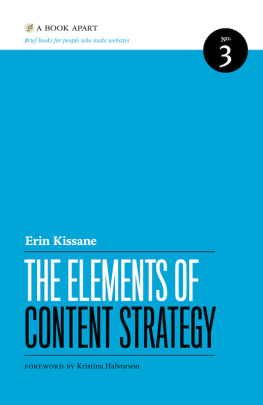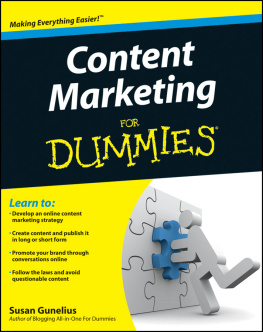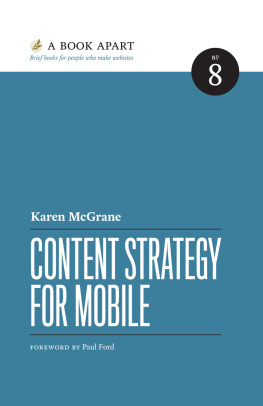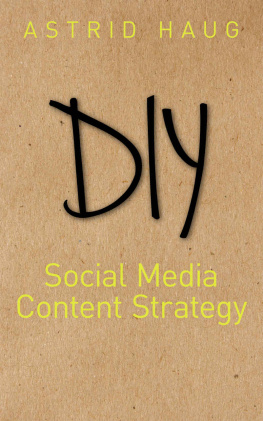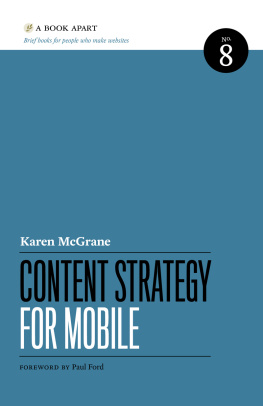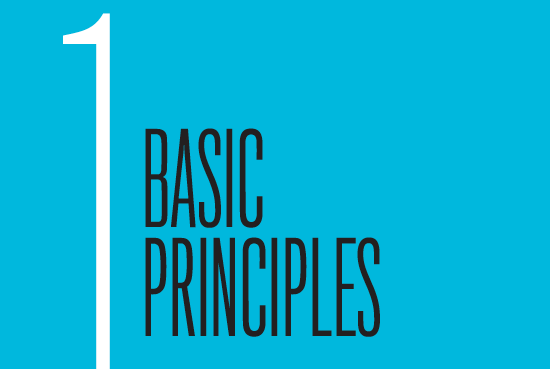Foreword
As you can see, the scourge is upon us, and we must, every one of us, be prepared to fight.
Erin Kissane , Attack of the Zombie Copy
Content is a hairy , complicated beast. Theres stuff to research, sift through, create, curate, correct, scheduleand thats before we start to think about publishing. What layout makes the most sense for this content? What organization? What metaschema? What platforms? Never mind post-launch plans, or lack of resources, or stakeholder alignment, or, or... yikes. No wonder we want to hide under the bed.
The content beast does not scare Erin Kissane. In fact, for her entire adult life, shes been quietly taming it with a firm but gentle hand. As part of her heros journey, Kissane has collaborated with countless designers, developers, UXers, marketers, editors, and writers on projects of all sizes. This is good news for you: no matter what role you play, she gets what you do and knows why its important. And, because she cares, she wants to help you understand how content strategy can help make your life a little easierand your end products a little more awesome.
Not that long ago, I wrote an article that called upon readers to take up the torch for content strategy. The book you hold in your hands is that torch. So run with it. Hold it high. Be confident in your pursuit of better content. You have The Elements of Content Strategy to light your way.
Come on out from under the bed. We have work to do.
Kristina Halvorson
Author, Content Strategy for the Web
CEO, Brain Traffic
Copyright 2011 by Erin Kissane
All rights reserved
Publisher: Jeffrey Zeldman
Designer: Jason Santa Maria
Editor: Mandy Brown
Copyeditor: Krista Stevens
ISBN 978-0-9844425-6-0
A Book Apart
New York, New York
http://books.alistapart.com
Introduction
Content strategy is to copywriting as information architecture is to design.
Rachel Lovinger
Content strategy plans for the creation, publication, and governance of useful, usable content.
Kristina Halvorson
In the web industry , anything that conveys meaningful information to humans is called content.
Every website has content. Companies with three-page websites probably only need a writer. But those with hundreds or thousands of pieces of online content need someone who can stand back and figure out what all that content should communicate. They also need someone to decide how best to communicate it, who should make it, and so ona sort of combination editor-in-chief and air traffic controller. They need a content strategist.
In the last few years, the value of content strategy has been articulated in dozens of blog posts, articles, and books, but its quite simple and worth repeating. Done well, content strategy:
- Helps companies understand and produce the kind of content their target audiences really need.
- Allows organizations to develop realistic, sustainable, and measurable publishing plans that keep their content on track in the long term.
- Cuts costs by reducing redundant or extraneous publishing efforts, while increasing the effectiveness of existing assets.
- Aligns communication across channels so that web content, print collateral, social media conversations, and internal knowledge management are working toward the same goals (in channel-appropriate ways).
- Prevents web projects from being derailed by the often major delays caused by underestimating the time and effort required to produce great content.
And this is only the beginning. Our discipline is in its infancy, and weve had only the tiniest peek at the internets full impact on the way we live and do business. Content strategy is rising because organizations all over the world have begun to realize that they desperately need it to handle their rapidly expanding online communications. Unless the planet gets hit by a comet, this trend is unlikely to reverse.
Whats in this book
This book is not an argument for the importance of content strategy. Neither is it a tutorial, a workbook, or a gallery of deliverables. It will not show you how to turn your BA in English into a $100,000 salary in ten easy steps. And it is emphatically not an exhaustive compendium of everything we know about content work. Instead it collects our disciplines core principles, competencies, and practices for easy reference, divided into three sections:
- Basic Principles lays out our disciplines shared values.
- The Craft of Content Strategy explores the collected expertise of the fields that have contributed the most to our work.
- Tools and Techniques provides a brisk walkthrough of approaches, methods, and deliverables used in the daily practice of content strategy.
You might think of these pieces as a (very) brief handbook, an introduction to a panel of potential mentors, and the key to the supply cabinet. Begin wherever you wish and end where you please. In the back of the book are additional examples and resources. When youre done here, please join the raucous online content conversation, if you havent already.
When I get stuck on a project or intimidated by a blank page, there are a handful of books I reach for to remind myself what my options are: what else to try, what criteria I should use to judge my work, and how I might think differently about the obstacles ahead. If this book can be such a reference for some of you, Ill consider it a great success.
Onward.
In content strategy , there is no playbook of generic strategies you can pick from to assemble a plan for your client or project. Instead, our discipline rests on a series of core principles about what makes content effectivewhat makes it work, what makes it good. The first section of this book is organized around these fundamentals.
Good Content is Appropriate
Publish content that is right for the user and for the business
Theres really only one central principle of good content: it should be appropriate for your business, for your users, and for its context. Appropriate in its method of delivery, in its style and structure, and above all in its substance. Content strategy is the practice of determining what each of those things means for your projectand how to get there from where you are now.
Right for the user (and context)
Let us meditate for a moment on James Bond. Clever and tough as he is, hed be mincemeat a hundred times over if not for the hyper-competent support team that stands behind him. When he needs to chase a villain, the team summons an Aston Martin DB 5. When hes poisoned by a beautiful woman with dubious connections, the team offers the antidote in a spring-loaded, space-age infusion device. When he emerges from a swamp overrun with trained alligators, it offers a shower, a shave, and a perfectly tailored suit. It does not talk down to him or waste his time. It anticipates his needs, but does not offer him everything he might ever need, all the time.
Content is appropriate for users when it helps them accomplish their goals.
Content is perfectly appropriate for users when it makes them feel like geniuses on critically important missions, offering them precisely what they need, exactly when they need it, and in just the right form. All of this requires that you get pretty deeply into your users heads, if not their tailoring specifications.
Part of this mind-reading act involves context, which encompasses quite a lot more than just access methods, or even a fine-grained understanding of user goals. Content strategist Daniel Eizans has suggested that a meaningful analysis of a users context requires not only an understanding of users goals, but also of their behaviors: What are they doing? How are they feeling? What are they capable of? ( FIG 1 )

